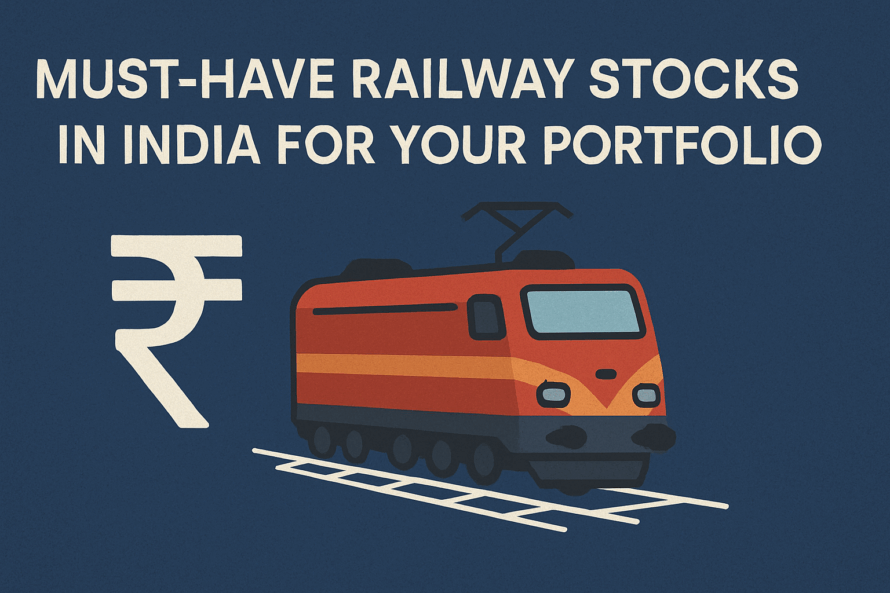
With more than 13,000 passenger trains running daily, India’s railway network covers more than 68,000 kilometres. As the Indian Railways expands rapidly and boosts economic growth, including railway stocks in your investment portfolio can be beneficial. Thanks to the government’s attention to improving the railway sector, companies related to Indian Railways are likely to do well in the coming years.
There are opportunities in this sector for people interested in rail companies, providers of rail services, and makers of rail-focused technology. In this blog post, we present some top railway stocks from India that indicate the sector’s resilience. These railway stocks have the potential to provide good future profits, making them excellent choices for all investors. Let’s dig in.
Essential railway stocks in India for your portfolio based on market capitalization
The expansion of the transportation industry is an opportunity for investors in India’s top railway stocks. Investing in railway stocks in India is popular because they can give investors steady returns. The following is a list of the best railway stocks based on analysts’ reviews and market capitalization.
1. Indian Railway Finance Corp. Ltd.
IRFC, which stands for Indian Railway Finance Corp Ltd, was established in 1986. Further, the finance and leasing division is the financial arm of the Indian Railways. As of May 19, 2025, IRFC’s market capitalization is around ₹184,906 Cr.
IRFC primarily borrows money from the financial markets to finance the production or purchase of assets, leasing them to the railroads for further development.
2. IRCTC Ltd.
In 1999, the Indian Railway Catering and Tourism Corporation Limited was established. IRCTC performs many functions, like selling tickets, food, and packaged water.
It provides a wide range of services to meet all travelers’ requests. Executive lounges, dorms, retiring rooms, bottled water, mobile catering services, and many more amenities are among the most common offerings. As of May 19, 2025, IRCTC’s market capitalization is around ₹64, 336 Cr.
3. Rail Vikas Nigam Ltd.
RVNL, or Rail VikasNigam Limited, is in charge of building all railway facilities. Besides, its primary business is building infrastructure like new lines, bridges, workshops, production units, power lines, and many more. As of 19 May 2025, the market cap of Rail Vikas Nigam is around ₹ 89,968Cr.
RVNL has a massive list of clients, ranging from government offices to central government agencies. It is an essential body in charge of many types of railway projects, such as railway electrification, building metros, cable-stayed bridges, and more.
4. Container Corporation of India Ltd.
Container Corporation of India Ltd. (CONCOR) provides transportation and logistical services. EXIM and Domestic are its two main segments. Moreover, it handles operations, shipping, and storage.
Container Corp’s market capitalization was around ₹45,188 Cr as of May 19, 2025. It was started in 1988 and has been a key player in transporting and managing containers on railways, roadways, airways, and other modes of transportation ever since.
5. Ircon International Ltd.
The Ministry of Railways established Ircon International Ltd. in 1976 as a combined engineering and construction business. Besides, the infrastructure it works on includes roads, bridges, metros, tunnels, railway electrification, and more. As of May 13, 2025, Ircon International’s market capitalization is around ₹18565.78 Cr.
Understanding the dynamics of railway stocks in India
To understand how Indian railway stocks behave, you must study government policies, infrastructure growth, privatization trends, and market demand. In this industry, these elements significantly impact stock performance and investor mood.
1. Market Trends and Growth Potential
To a large extent, changes in demand and larger market trends impact how well the railway business does. The following factors influence this:
- Impact of Seasons: Passenger demand is highest during holiday seasons, but freight demand varies according to industrial productivity and agricultural harvests.
- Worldwide Events: Geopolitical events, trade policies, and problems in the global supply chain can all affect the railway freight market, which in turn can impact stock performance.
- Government policies: For railroad corporations like IRCON and RVNL, investments in electrification projects or high-speed rail tracks can open up growth prospects.
2. Key Players and Their Market Influence
Private companies are becoming increasingly important in the growth of Indian Railways, building on the government’s work.
- Developing Partnerships: Private companies have been getting government contracts to make things, keep them in good shape, and run businesses. For example, about $15.3 billion is set aside to build passenger cars, which helps companies like BEML and Titagarh Rail Systems.
- Shifts in Railway Stocks: Privatization has brought greater success and higher demand for railway stocks. Involving the business sector should make activities even more efficient and profitable.
- Market Growth: Private companies can now use freight ports as part of the PM Gati Shakti program, an infrastructure development plan. This should improve operations and help the sector grow even more.
Investment strategies for railway stocks
To make wise decisions about investing in railway stocks, you must do much research first. Before adding railway stocks to your portfolio, here are the most important things you should consider.
1. Analyzing Financial Health of Rail Companies
Start by assessing a company’s financial health. Look for steady income growth as a sign that the business is growing and demand is rising. Check the company’s profit margins to see how well it turns sales into profits; bigger margins usually mean the company is good at controlling costs and setting prices.
To do this, look over cash records like the ones below:
- Balance Sheet: Keep debt levels low, because too much debt could mean taking on too much financial risk.
- Income Statement: Determine patterns in operational income, pre-tax profit, and unusual costs.
- Cash Flow Statement: Pay attention to companies that have good cash flows from operations. Moreover, this shows that they can keep and grow their business.
2. Timing the Market: When to Buy and Sell
Timing the market is significant if you want to make the most money from railway stocks. Take a look at these strategies:
- Observe Economic Indicators: Pay attention to infrastructure investment and macroeconomic variables, as they might affect the performance of railway stocks.
- Monitor Policy Announcements: Budgets and changes in government policy can significantly affect the sector. For instance, big spending cuts in the Union Budget can make investors feel better about their money.
- Technical Analysis: Using basic signs such as moving averages and support/resistance levels to find entry and exit points.
- Remain Up to Date: Follow news and professional opinions often to keep up with industry advancements.
Investors can make better choices in the Indian railway sector using basic research and market timing techniques.
The impact of government policies on railway stocks
The total expenditure of the Indian Railways is estimated to increase to about 2.8 trillion rupees at the end of the fiscal year 2025. Besides, government budget allocations and privatization influence Indian railway equities. Additionally, infrastructure investments and regulatory changes impact profitability and growth.
1. Recent Initiatives and Their Effects
Recent initiative and their effects on railway stocks are as follows:
- Policy Continuity: Policy continuity makes investors more confident in Indian Railway Stocks.
- Budget Allocations: Within the Union Budget 2025–26, the government set aside ₹2.62 lakh crore for railway capital spending. Therefore, by allocating funds, railway companies can complete rail electrification projects and develop high-speed rail corridors.
2. Future Prospects Based on Government Plans
There are many business opportunities in the Indian railway sector, which is about to experience significant growth.
- Developing Infrastructure: By upgrading rail coaches and introducing semi-high-speed Vande Bharat trains, railway services can be improved, attracting investors to enterprises engaged in these initiatives.
- Innovations in Technology: Offering e-catering services and cloud kitchens, which open new ways to make money, IRCTC is committed to customer-centred growth.
Conclusion
The government’s attention to building and improving facilities will help the top railway stocks in India grow. Many companies deal in different industries, providing customers opportunities to invest in railway stocks. However, before making any investment decision, one must carefully consider the risks and benefits.
FAQs
Q. What makes railway stocks a good investment?
Consistent modernization and strong government support have made the industry more important for India’s infrastructural development. Railway stocks are a perfect choice for investors looking for consistent profits and long-term growth.
Q. How do government policies affect railway stock prices?
Legislation and government policies affect infrastructure building, running efficiency, economic growth, and railroad stock prices. Government projects like infrastructure development will improve demand for rail services.
Q. What are the risks involved in investing in railway stocks?
Investing in railway shares comes with its share of downsides. These include excessive debt, declining demand, competition from alternative types of mobility, legislative changes, and cyclical industry patterns.







